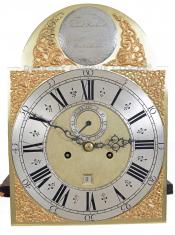Samuel Rockwell of Providence, Rhode Island. A Pre-revolutionary made tall case clock. CCC-25.
This is an important mahogany-cased tall clock made by Samuel Rockwell of Providence, Rhode Island, circa 1747. Rockwell was an early Providence clockmaker. Very few American Pre-Revolutionary clocks were made in this country, and fewer survived. This is a fine early Rhode Island example.
This Queen Anne-style mahogany exhibits excellent selections of wood that feature an attractive grain pattern. The pattern is enhanced with a modern shellac finish. This is how the case presented itself when first made in the middle of the 1740s. The cabinet is elevated on four nicely formed ogee-bracket feet. These are applied to the lower base molding. The base is somewhat compressed, a standard design detail for clock cases manufactured in the Colonies during this early period. The waist section is long and centers a large tombstone-shaped waist door. This door is trimmed along its perimeter with applied molding. The hinged door opens to allow one access to the case's interior. One will find the two drive weights and the brass-faced pendulum bob. The bonnet features a pagoda top. This style of bonnet is also an early form. This design feature is positioned above a molded arch that conforms to the shape of the dial door and the dial. The front corners of the pagoda are blocked, forming plinths. Two turned wooden ball-and-spiked finials are mounted out on the corners of the hood. Two free-standing colonettes visually support the molded arch. These are smoothly turned and feature Doric-shaped wooden capitals. Two additional quarter columns are mounted at the back corners of the hood. The sidelights are also a tombstone shape and fitted with glass. The bonnet door is arched in form and opens to access the composite brass dial.
This style of dial predates the painted dial form. It is composed of a brass sheet and is decorated with several decorative elements. Four cast corner spandrels frame the applied time ring. These are designed with a woman's head and headdress surrounded by flowers. Two additional dolphin spandrels are in the arch, centering a circular name-boss. The boss is a slightly convex form having an engraved wheat-ear border. The center is engraved with the Maker's name and city location. The reads, "Samuel Rockwell / Providence." The time or chapter ring is engraved with Arabic-style five-minute markers separated by a closed minute ring from the large Roman-style hour numerals. An interior minute is also present on this dial. It is rare to see this scale on American clocks. Fleur-de-lis decorated the area between each hour. Inside this ring, the dial surface has been textured or matted so that one can locate the hands of the clock more easily. The hands are filed steel and display the time. One will also find a display for the calendar day and a subsidiary seconds dial in this location.
The two-train movement is brass, has an eight-day duration, and is good quality. Five turned pillars or posts support the two large brass plates. Hardened steel shafts support the polished steel pinions and brass gearing. The winding drums are grooved. The escapement is designed as a recoil format. The weight-driven movement is intended to run for eight days on a full wind. It features a having a rack and snail striking system. As a result, it will strike each hour on the hour on a cast iron bell mounted above the movement.
Rockwell made this clock circa 1747 or before he moved to Hampton, Virginia, in 1752. The case stands approximately 7 feet 9 inches (93 inches) tall to the top of the finials, 19 inches wide, and 10 inches deep at the cornice molding.
Inventory number CCC-25.
Samuel Rockwell was born on October 13, 1722, in Middletown, Connecticut. His parents were Joseph (1697-1757) and Savanna (Yeomans) Rockwell, who married in Middletown on December 21, 1721. Samuel is thought to have trained as a clockmaker in Providence, Rhode Island. His training would have started about 1735, and he would have become a journeyman clockmaker by 1742. Samuel worked in Providence until 1752. A tall clock is known signed with the place location of Providence. In 1752, he moved to Hampton, Virginia, making him the first clockmaker known in the Virginia colony. He advertised in October of 1752 in the Virginia Gazette that he made, sold, and cleaned clocks and watches in his shop in Hampton. He also had clocks for sale in Mr. Finnie's shop in Williamsburg. Samuel worked here until 1755. During this time, he also began trading goods such as coffee, sugar, and molasses in New York City. He also owned a sloop of 60 tons. In 1752, he moved to Philadelphia, PA. In 1762, he moved back to Middletown, Conn. In 1763, he married Abigail Goodwin Johnson, the widow of Daniel Johnson. Samuel died in Middletown in 1773, insolvent.














